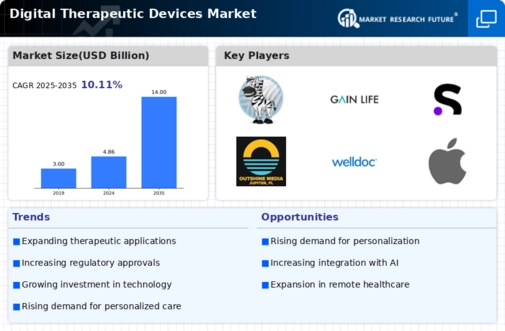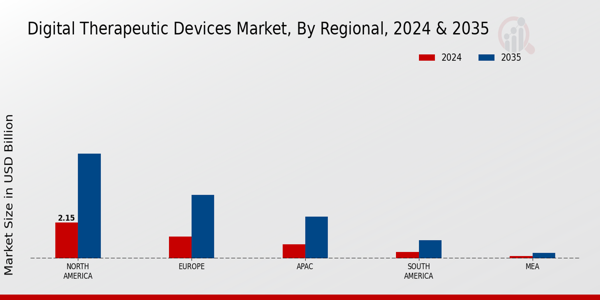Market Growth Chart
Focus on Preventive Healthcare
The global shift towards preventive healthcare is significantly impacting the Global Digital Therapeutic Devices Market Industry. As healthcare systems prioritize prevention over treatment, digital therapeutics emerge as effective tools for managing health proactively. These devices enable individuals to monitor their health metrics and receive timely interventions, thereby reducing the burden of chronic diseases. The emphasis on preventive measures aligns with the increasing healthcare costs associated with untreated conditions. Consequently, the market is poised for growth, with projections indicating a rise to 14 USD Billion by 2035, as more individuals and healthcare systems adopt digital therapeutic solutions.
Rising Prevalence of Chronic Diseases
The increasing incidence of chronic diseases globally is a primary driver for the Global Digital Therapeutic Devices Market Industry. Conditions such as diabetes, cardiovascular diseases, and mental health disorders are becoming more prevalent, necessitating innovative management solutions. For instance, diabetes alone affects over 463 million adults worldwide, highlighting the urgent need for effective therapeutic interventions. Digital therapeutics provide personalized treatment plans and real-time monitoring, which can significantly enhance patient outcomes. As the market is projected to reach 4.86 USD Billion in 2024, the demand for these devices is likely to grow, indicating a robust market trajectory.
Technological Advancements in Healthcare
Rapid advancements in technology are transforming the healthcare landscape, thereby propelling the Global Digital Therapeutic Devices Market Industry. Innovations in artificial intelligence, machine learning, and mobile health applications are enabling the development of sophisticated digital therapeutics that offer personalized treatment options. For example, AI-driven platforms can analyze patient data to tailor interventions effectively. This technological evolution not only enhances patient engagement but also improves adherence to treatment regimens. With the market expected to expand to 14 USD Billion by 2035, the integration of cutting-edge technologies is likely to play a crucial role in shaping future therapeutic solutions.
Regulatory Support and Reimbursement Policies
Support from regulatory bodies and favorable reimbursement policies are crucial drivers for the Global Digital Therapeutic Devices Market Industry. Governments and health organizations are increasingly recognizing the value of digital therapeutics, leading to the establishment of frameworks that facilitate their integration into healthcare systems. For instance, the inclusion of digital therapeutics in reimbursement schedules encourages healthcare providers to adopt these solutions. This regulatory backing not only enhances market credibility but also fosters innovation within the industry. As the market evolves, such supportive measures are likely to contribute to its growth and sustainability.
Growing Acceptance of Digital Health Solutions
The increasing acceptance of digital health solutions among patients and healthcare providers is significantly influencing the Global Digital Therapeutic Devices Market Industry. Patients are becoming more comfortable utilizing digital platforms for managing their health, while healthcare professionals recognize the potential of these tools to enhance patient care. This shift is evidenced by the growing number of digital therapeutic applications available, which cater to various health conditions. As a result, the market is anticipated to experience a compound annual growth rate of 10.1% from 2025 to 2035, reflecting the rising demand for effective digital health interventions.

























